Ivan Čuk
Foreword
Khudolii O.M., Ivashchenko O.V., Iermakov S.S., Rumba O.G
COMPUTER SIMULATION OF JUNIOR GYMNASTS’ TRAINING PROCESS
Thomas Heinen, Freya Krepela
EVALUATING ROUTINES IN TRAMPOLINE GYMNASTICS
Damian Jeraj
ERROR PERCEPTION IN GYMNASTICS: TWO CONSECUTIVE INTERVENTIONS
George Dallas, Kostas Dallas, Jeremy Siatras
NUTRITIONAL STATUS AND DIETARY ASSESSMENT OF ELITE FEMALE ARTISTIC AND RHYTHMIC GYMNASTS – A CASE STUDY
H. Antonio Pineda-Espejel, Edgar Alarcón, Marina Trejo, Carlos Chávez, Raquel Arce
PERSONAL FACTORS ASSOCIATED WITH PRE-COMPETITIVE ANXIETY IN ELITE GYMNASTS
Lenka Svobodová, Alena Skotáková, Petr Hedbávný, Pavlina Vaculíková, Martin Sebera
USE OF THE DANCE PAD FOR THE DEVELOPMENT OF RHYTHMIC ABILITIES
Anton Gajdoš
Short Historical Notes VII
Ivan Čuk
Foreword
Since our last issue in June two major and important events signed this period of time. The first event were Olympic Games in Rio. All gymnastics competitions were of excellent quality, battles for the win were almost epic (e.g. Kohei Uchimura (Japan) versus Oleg Vernjajev (Ukraina). Some were surprises and some were disappointed. But most of all is important our sport was not part of doping issues and I’m glad FIG did not banned Russia from the gymnastics events. Afterwards Fancy Bears published some interesting documents, of which we should in near future also discus in philosophical way and to answer simple (but hard) question, is it sport proper place for those who are chronically ill? Isn’t statement Mens sana in corpore sano still valid. We would be pleased if some of you readers and researchers can give more profound answers on such questions. Legal is not also legitimate. The second important event were just finished elections for new FIG structure. Now the ex-president Bruno Grandi had a hard work how to put different aims of very different gymnastics developed countries into same direction. In his way there were many obstacles. But also many important changes, which changed our sport significantly. Fort the first, he added Trampoline, Acrobatic and Aerobic Associations under FIG umbrella. Trampoline is since 2000 also Olympic discipline (probably the most spectacular one). Sports Aerobic is part of World Games, and Acrobatic just gained to be sport discipline at next Youth Olympic Games. As a professor he did took opportunity and established Academy, which functions excellent, and also new FIG members are the result of shared knowledge in world. Perhaps new Scientific Commission did not had direct influence on Code of Points changes, but had an impact on awareness of gymnasts health, and for the first time publicly with scientific tools denied that gymnasts are small because of sport they practice. It is worth to mention open ended Code of Points, which well defines gymnast's quality, was under his presidency, where perfect 10 for execution remained (but hardly achieved). We need to thank prof. Bruno Grandi also for his support for our Journal. So for you did well prof. Bruno Grandi thank you. I would like to congratulate new president Morinari Watanabe from Japan for his victory at presidential votes, which gave him almost unanimously support for leading our sport in future. Would be pleased if he will continue to develop our sport into most influential Olympic sport, with well defined worldwide competition system, which can serve to all countries. I believe researchers and authors of articles in our Journal will be willing to research and give answers on qustions which can arise. Dear reader, in this issue we start with article from Ukraine research team lead by O.M. Khudolii, followed by two articles from German authors Thomas Heinen Freya Krepela and Damian Jeraj. Three more groups of authors were from Greece, lead by George Dallas, Mexico lead by H. Antonio Pineda-Espejel and Czech Republic lead by Lenka Svobodová. Anton Gajdoš added new Short historical note. Just to remind you, if you quote the Journal: its abbreviation on the Web of Knowledge is SCI GYMN J. I wish you pleasant reading and a lot of inspiration for new research projects and articles.
Khudolii O.M., Ivashchenko O.V., Iermakov S.S., Rumba O.G
COMPUTER SIMULATION OF JUNIOR GYMNASTS’ TRAINING PROCESS
The purpose of the research is to develop methodological approach to creation of an algorithm of informational provisioning of children’s and adolescents’ training of motor actions. The research was conducted in compliance with a plan of factorial experiment of 22 type. The received materials were used for simulation of gymnast training process. At initial stage of training, we analyzed 530 sessions (92 gymnasts of 7-10 years old age). At the stage of basic training, we analyzed 580 trainings (78 gymnasts of 11-13 years old age). For determination of different training modes’ influence on change of functional state of cardio-vascular and nervous-muscular systems we conducted a five-year longitudinal prospective research (60 gymnasts). We produced an algorithm of informational provisioning of child and adolescent training to motor actions. The algorithm is based on computer simulation of a training process. We found that the progress in fulfillment of exercise depends statistically significantly on the group of following indicators: level of fitness, organization of load and orientation of training. We provide data about change of training results and pulse frequency. We show that factorial experiment’s results were reliable and effective in determination of different working modes’ influence on functional state and gymnast ability for mastering of motor actions. Algorithm of calculation of normative loads for gymnasts was worked out. The offered algorithm of computer simulation of training process’s simulation permits receiving new information about fitness, organization of load and orientation of training influence on effectiveness of motor skill formation. http://www.fsp.uni-lj.si/ads/util/mma_bin.php?id=20161026155127
Keywords: gymnast, information, motion, training, load, schoolchildren, training.
Thomas Heinen, Freya Krepela
EVALUATING ROUTINES IN TRAMPOLINE GYMNASTICS
In trampoline gymnastics, judges’ task is to evaluate a particular routine based on the evaluation of overall degree of difficulty, overall skill execution, and the measurement of time of flight duration. The aim of this study was to investigate differences in the three judgment variables between gymnast’s age, gymnast’s gender, year of competition, and in relation to the final competition standings in trampoline gymnastics. N = 279 datasets from the World Championships and World Age Group Competitions of the years 2011, 2013, 2014, and 2015 served as a database for this study. Results revealed that the judgment variables varied as a function of gymnasts’ age, gymnasts’ gender, and year of competition. For example, male gymnasts exhibited higher difficulty scores, slightly higher execution scores, higher time of flight scores, and higher total scores as compared to their female counterparts. A similar pattern of results was found when comparing senior gymnasts to gymnasts from younger age groups. Furthermore, all three judgment variables contributed to final competition standings. Difficulty score showed in average a larger contribution while execution score showed in average a tendency to a slightly smaller contribution for male gymnasts, as compared to female gymnasts. From the viewpoint of an individual gymnast, it is concluded that execution score of a routine should be maximized, while time-of-flight score should be optimized given the difficulty that a gymnast is able to present in a particular routine, thereby guaranteeing a safe and deduction-free skill performance.
Keywords: constraints, degree of difficulty, execution score, time of flight measurement.
Damian Jeraj
ERROR PERCEPTION IN GYMNASTICS: TWO CONSECUTIVE INTERVENTIONS
The coach’s perception of movement errors is crucial for the feedback. Two consecutive studies investigated exploratory the influence of transfer of knowledge (study 1; S1) and the influence of motor experience (study 2; S2) on error perception rate of the gymnastics element handstand with a roll. Participants of S1 (n = 18) and S2 (n = 21) are distributed to either a control or an intervention condition. The error perception rate of a video test was used as the dependent variable. Interventions consisted of 180 minutes transfer of knowledge sessions (S1) and 90 executions of handstand with a roll (S2). The mental structure (S1) and an execution protocol with subjective performance are used for monitoring. The error perception rate increased significantly for all conditions. An influence of transfer of knowledge and motor experience was not found. A systematic change in the mental structure on the descriptive level and a subjective improvement of the handstand performance was found. The overall increase of the error perception rate is seen as a learning effect. It remains unclear whether there are long term effects on error perception and to what extent changes of mental structure and subjective performance can be used for the feedback.
Keywords: augmented feedback, movement errors, perception, coaching.
George Dallas, Kostas Dallas, Jeremy Siatras
NUTRITIONAL STATUS AND DIETARY ASSESSMENT OF ELITE FEMALE ARTISTIC AND RHYTHMIC GYMNASTS – A CASE STUDY
Pre-adolescence and adolescence athletes of aesthetic sports such as artistic and rhythmic gymnastics are at high risk of deficiency in basic nutrients. The increasing demands of puberty combined with the intense daily training without adequate nutrition, exposes the young athletes to growth disorders, severe nutritional deficiencies, problems of emotional nature, dissatisfaction with body image (i.e., obsession with physical appearance), hormonal disorders (amenorrhea), chronic fatigue, osteopenia and especially an increased risk of injuries. The purpose of this study was to assess the dietary intake and identify nutritional deficiencies and/or possible excess intake (unhealthy nutrition), thus potential dietary risks and abnormal eating habits. Self-esteem and perception of body image were also assessed. Τwo young female athletes, οne artistic (AG) and one rhythmic gymnast (RG), members of the Greek national team were surveyed. The dietary history and the 7-day weighed food record protocol revealed an average daily energy intake of 1712 ± 165 Kcal and 1976 ± 219 kcal, respectively (or ~ 42,5 kcal/kg lean mass) and inadequate consumption of carbohydrates. The calcium intake had the highest deviation from the recommended daily requirements. Both athletes reported daily individual weighings. A high number of serious injuries and menstrual dysfunction were also reported with one of the athletes presenting a strong predisposition to nutritional risk factors and pathological eating behaviour, and negative emotions both with the external appearance and the body weight. The use of dietary supplements was not mentioned by any athlete. Therefore, targeted nutritional guidelines and psychological support for young elite athletes are required.
Keywords: gymnastics, females, nutritional status, dietary intake.
H. Antonio Pineda-Espejel, Edgar Alarcón, Marina Trejo, Carlos Chávez, Raquel Arce
PERSONAL FACTORS ASSOCIATED WITH PRE-COMPETITIVE ANXIETY IN ELITE GYMNASTS
The aim of this study was to analyze how goal orientations and two facets of perfectionism –striving for perfection and negative reactions to imperfection- be related to precompetitive anxiety in elite gymnasts. Thirty seven artistic gymnasts answered a series of questionnaires to measure the study variables. The results showed that cognitive anxiety was related to negative reactions to imperfection, while the self-confidence was predicted by the task orientation. In conclusion, aspects of personality, such as task orientation and negative reactions to imperfection, anticipate the cognitive self-confidence and anxiety, respectively, at the time previous to a senior gymnastics competition.
Keywords: personality, effort, perfection, goal orientations, emotion.
Lenka Svobodová, Alena Skotáková, Petr Hedbávný, Pavlina Vaculíková, Martin Sebera
USE OF THE DANCE PAD FOR THE DEVELOPMENT OF RHYTHMIC ABILITIES
In our research we assessed the effect of an intervention programme based on regular use of the dance pad on the level of rhythmic abilities as important factors influencing the performance in gymnastic sports, dancing, figure skating and so on. The sample consisted of 28 dancers aged between 8-13 years. The tested persons were divided into 2 groups according to age and length of dance practice. Each group was then divided into experimental and control group. Experimental groups were asked to dance on the dance pad 3 times a week for two and a half months. The level of rhythmic perception was measured by the test of rhythmic discrimination by Seashore. The level of rhythmic execution was measured by the test Software reaction meter and Hands and feet drumming. For data analysis of rhythmic abilities we chose descriptive statistics and T-test, calculation of Cohen's d coefficient and Spearman rank correlations. Although the research did not confirm positive influence of dance pad on the development of rhythmic abilities of the tested persons, more options to investigate were shown.
Keywords: rhythmic perception, rhythmic execution, intervention programme, testing.
Anton Gajdoš
Short Historical Notes VII
Miroslav Klinger about FIG events 1946-1948.





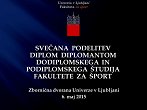
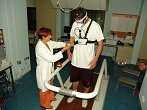
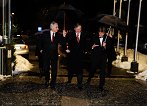
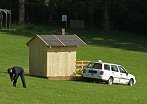







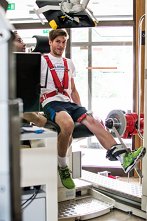



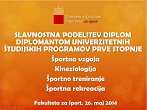








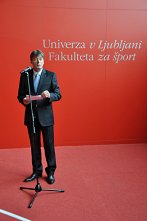
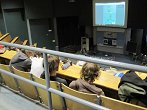



.png)